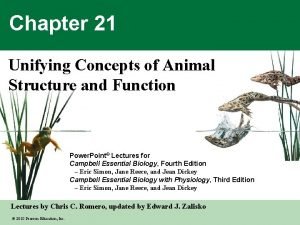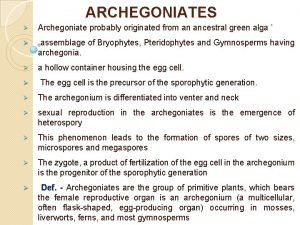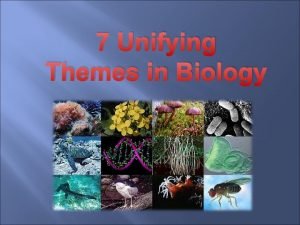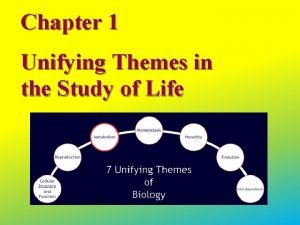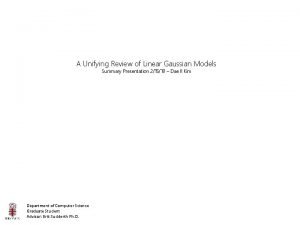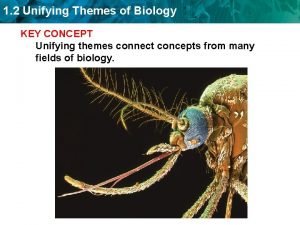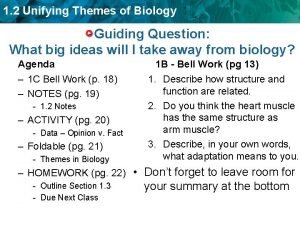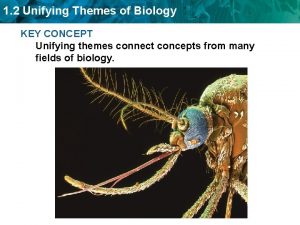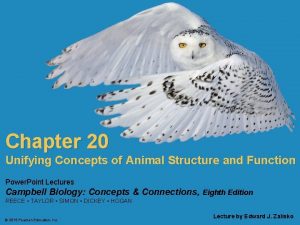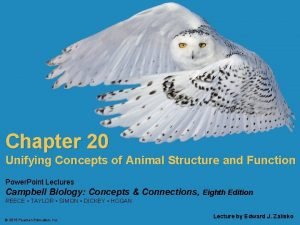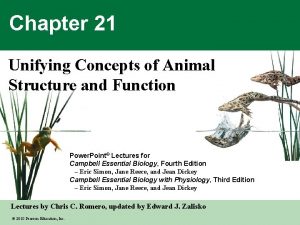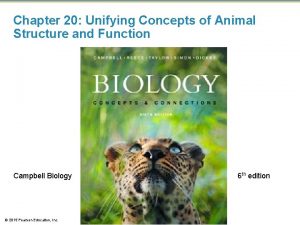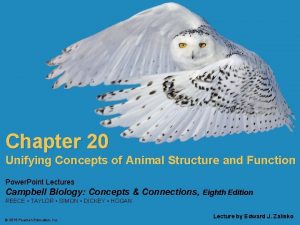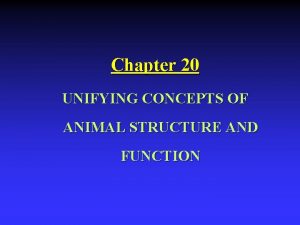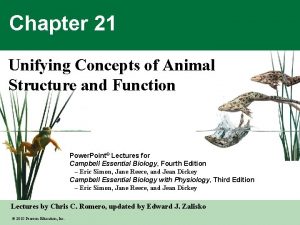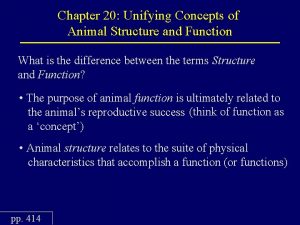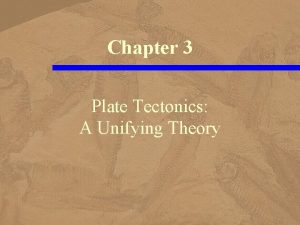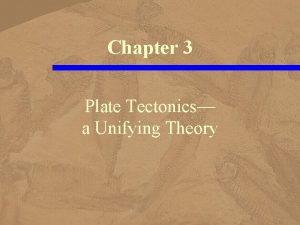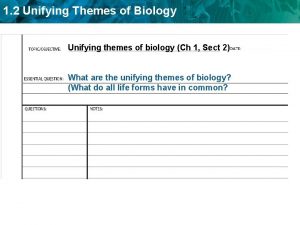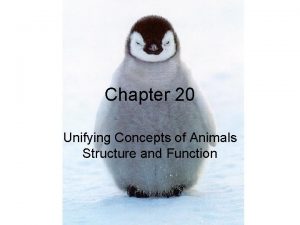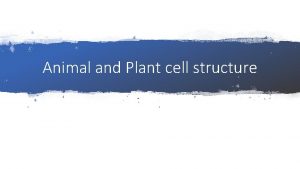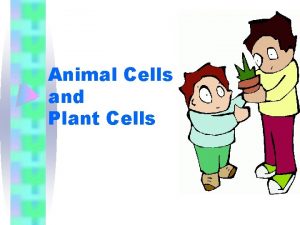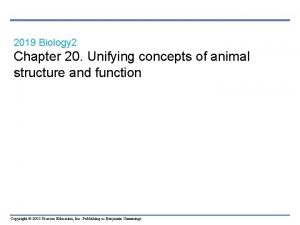Chapter 20 Unifying Concepts of Animal Structure and






























- Slides: 30

Chapter 20 Unifying Concepts of Animal Structure and Function 0

THE HIERARCHY OF STRUCTURAL ORGANIZATION IN AN ANIMAL 20. 1 Structure fits function in the animal body a. Anatomy is the study of structure • Physiology studies how structures function

a. The functions of specific structures a. Result from their specific structures Forearm Wrist Finger 1 Palm Shaft Finger 2 Finger 3 Shaft Feather structure Barbule Hook Figure 20. 1 Internal bone structure 0

0 20. 2 Animal structure has a hierarchy a. Structure in the living world o Is organized in a series of hierarchical levels A Cellular level Muscle cell B Tissue level Muscle tissue C Organ level Heart D Organ system level Circulatory system E Organism level Many organ systems functioning together Figure 20. 2 A–E

20. 4 Epithelial tissue covers the body and lines its organs and cavities a. Epithelial tissue occurs as sheets of closely packed cells o That cover surfaces and line the cavities and tubes of internal organs

a. Epithelial tissue a. Functions in protection, secretion, and exchange Basement membrane (extracellular matrix) 0 Free surface of epithelium Underlying tissue Cell nuclei A Simple squamous epithelium (lining the air sacs of the lung) D Stratified squamous epithelium (lining the esophagus) Layers of dead cells B Simple cuboidal epithelium (forming a tube in the kidney) Rapidly dividing epithelial cells Colorized SEM C Simple columnar epithelium (lining the intestine) Figure 20. 4 A–E E Stratified squamous epithelium (human skin)

20. 5 Connective tissue binds and supports other tissues a. The various types of connective tissue o Are characterized by sparse cells in an extracellular gel matrix

a. Connective tissue a. Binds and supports other tissues 0 Fat droplets Cartilageforming cells C Adipose tissue Cell nucleus Matrix D Cartilage (at the end of a bone) Collagen fibers Central canal B Fibrous connective tissue (forming a tendon) Cell Collagen fiber Elastic fibers Figure 20. 5 A–F A Loose connective tissue (under the skin) White blood cells Matrix Boneforming cells Red blood cell E Bone Plasma F Blood

20. 6 Muscle tissue functions in movement a. Skeletal muscle attaches bones by tendons and is responsible for voluntary movements of the body. • Cardiac muscle forms the contractile tissues of the heart. • Smooth muscle found on the walls of digestive tract, urinary bladder, arteries, and other internal organs.

a. The three types of muscle tissue Unit of muscle contraction Muscle fiber 0 Junction between two cells Nucleus Muscle fiber Nucleus B Cardiac muscle A Skeletal muscle C Smooth muscle Figure 20. 6 A–C

20. 7 Nervous tissue forms a communication network a. The branching neurons of nervous tissue o Transmit nerve signals that help control body activities 0 Cell body Nucleus Cell extensions LM 330 Figure 20. 7

0 20. 9 Several tissues are organized to form an organ a. Each organ is made of several tissues o That collectively perform specific functions Lumen Small intestine (cut open) Lumen Epithelial tissue (columnar epithelium) Connective tissue Smooth muscle tissue (2 layers) Connective tissue Figure 20. 9 Epithelial tissue

20. 10 Organ systems work together to perform life functions a. Each organ system o Has one or more functions

a. The digestive and respiratory systems a. Gather food and oxygen Mouth Esophagus Liver Nasal cavity Larynx Trachea Bronchus Stomach Small intestine Lung Large intestine Anus A Digestive system Figure 20. 10 A, B B Respiratory system

a. The circulatory system, aided by the lymphatic system a. Transports the food and oxygen b. The immune system a. Protects the body from infection and cancer Bone marrow Heart D Immune system Thymus Spleen E Lymphatic system Lymph nodes Blood vessels C Circulatory system Figure 20. 10 C–E Lymph vessels

a. The excretory system a. Disposes of certain wastes b. The endocrine and nervous systems a. Control body functions Pituitary gland F Excretory system Thyroid gland Kidney Thymus Adrenal gland Ureter Pancreas Urinary bladder Testis (male) Urethra Ovary (female) G Endocrine system Figure 20. 10 F–G

a. The integumentary system a. Covers and protects the body b. Skeletal and muscular systems a. Support and move the body Hair Cartilage Skin Nails I Integumentary system Figure 20. 10 I–K Skeletal muscles Bones J Skeletal system K Muscular system

a. The reproductive system a. Perpetuates the species Male Female Prostate gland Vas deferens Oviduct Ovary Urethra Penis Uterus Vagina Testis Figure 20. 10 L L Reproductive systems

CONNECTION 20. 11 New imaging technology reveals the inner body a. New technologies o Enable us to see body organs without surgery

X-rays a. X-rays o Can be used for imaging bones and teeth

CT a. Computed tomography (CT) scans o Are excellent diagnostic tools Figure 20. 11 A Figure 20. 11 B

MRI a. Magnetic resonance imaging (MRI) o Allows visualization of soft tissues

MRM a. Magnetic resonance microscopy (MRM) o Provides three-dimensional images of very small structures Figure 20. 11 C

PET a. Positron-emission tomography (PET) o Yields information about metabolic processes at specific locations in the body MAX Figure 20. 11 D HEARING WORDS SEEING WORDS SPEAKING WORDS GENERATING WORDS MIN

EXCHANGES WITH THE EXTERNAL ENVIRONMENT 20. 12 Structural adaptations enhance exchange between animals and their environment a. An animal must exchange materials o With its environment

a. Small animals with simple body construction a. Have enough surface area to meet their cells’ needs Mouth Diffusion Gastrovascular cavity Figure 20. 12 A Two cell layers 0

a. Larger, complex animals a. Have specialized structures that increase surface area b. Exchange of materials between blood and body cells a. Takes place through the interstitial fluid External environment CO 2 Mouth Food Animal Respiratory system Digestive system Nutrients Interstitial fluid Circulatory system Body cells Excretory system Intestine Anus Figure 20. 12 B Unabsorbed matter (feces) Metabolic waste products (urine)

a. The respiratory system a. Has an enormous internal surface area Figure 20. 12 C

20. 13 Animals regulate their internal environment a. In response to changes in external conditions o Animals regulate their internal environment to achieve homeostasis, an internal steady state External environment Internal environment Homeostatic mechanisms Large fluctuations Figure 20. 13 A Figure 20. 13 B Small fluctuations

20. 14 Homeostasis depends on negative feedback a. Negative feedback mechanisms o Keep internal variables fairly constant, with small fluctuations around set points Sweat glands secrete sweat that evaporates, cooling body Thermostat in brain activates cooling mechanisms Blood vessels in skin dilate and heat escapes Temperature rises above normal Thermostat shuts off cooling mechanisms Temperature decreases Homeostasis: Internal body temperature of approximately 36– 38 C Temperature increases Thermostat shuts off warming mechanisms Temperature falls below normal Blood vessels in skin constrict, minimizing heat loss Figure 20. 14 Skeletal muscles rapidly contract, causing shivering, which generates heat Thermostat in brain activates warming mechanisms
 Unifying concepts of animal structure and function
Unifying concepts of animal structure and function Unifying features of archegoniate
Unifying features of archegoniate 7 themes of biology
7 themes of biology Unifying themes concept map
Unifying themes concept map A unifying review of linear gaussian models
A unifying review of linear gaussian models Types of plate boundaries
Types of plate boundaries 5 unifying themes of biology
5 unifying themes of biology 5 themes of biology
5 themes of biology Unifying theme definition
Unifying theme definition Unifying healthcare data
Unifying healthcare data 5 unifying themes of biology
5 unifying themes of biology On unifying deep generative models
On unifying deep generative models Plant cell and animal cell venn diagram
Plant cell and animal cell venn diagram Animal rights versus animal welfare
Animal rights versus animal welfare Difference of animal cell and plant cell
Difference of animal cell and plant cell Chapter 17 promotional concepts and strategies answer key
Chapter 17 promotional concepts and strategies answer key Promotional concepts and strategies
Promotional concepts and strategies Part two analyzing transactions in a cash control system
Part two analyzing transactions in a cash control system Reviewing concepts and vocabulary chapter 1
Reviewing concepts and vocabulary chapter 1 Chapter 2 basic concepts and proofs answers
Chapter 2 basic concepts and proofs answers Introduction and mathematical concepts
Introduction and mathematical concepts Chapter 1 managerial accounting and cost concepts
Chapter 1 managerial accounting and cost concepts Chapter 1 managerial accounting and cost concepts
Chapter 1 managerial accounting and cost concepts Animal farm comprehension questions and answers
Animal farm comprehension questions and answers Cytoplasm function
Cytoplasm function Chapter 33 entrepreneurial concepts answers
Chapter 33 entrepreneurial concepts answers Chapter 15 developing fraction concepts
Chapter 15 developing fraction concepts A survey of probability concepts chapter 5 solutions
A survey of probability concepts chapter 5 solutions What are the five basic concepts of democracy
What are the five basic concepts of democracy Prerequisites fundamental concepts of algebra
Prerequisites fundamental concepts of algebra Chapter p prerequisites fundamental concepts of algebra
Chapter p prerequisites fundamental concepts of algebra
